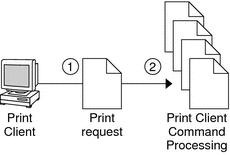How the Solaris Printing Software Locates Printers
The following figure highlights the part of the print process in which the printing software checks a hierarchy of printer configuration resources to determine where to send the print request.
Figure 2–2 How the Print Client Software Locates Printers

-
A user submits a print request from a print client by using the lp or lpr command. The user can specify a destination printer name or class in any of three styles:
-
Atomic style, which is the lp command and option, followed by the printer name or class, as shown in this example:
% lp -d neptune filename
-
POSIX style, which is the print command and option, followed by server:printer, as shown in this example:
% lpr -P galaxy:neptune filename
-
Context-based style, as shown in this example:
% lpr -d thisdept/service/printer/printer-name filename
-
-
The print command locates a printer and printer configuration information as follows:
-
The print command checks to see if the user specified a destination printer name or printer class in one of the three valid styles.
-
If the user didn't specify a printer name or class in a valid style, the command checks the user's PRINTER or LPDEST environment variable for a default printer name.
-
If neither environment variable for the default printer is defined, the command checks the sources configured for the printers database in the /etc/nsswitch.conf file. The naming service sources might be one of the following:
-
LDAP directory information tree in the domain's ou=printers container
-
NIS printers.conf.byname map
-
NIS+ printers.conf_dir map
-
-
- © 2010, Oracle Corporation and/or its affiliates
